Art World
Zhang Xiaoli Upends Traditional Chinese Painting Techniques in Her ‘Mini Zoo’ of a Studio
The artist's solo show is currently on view at New York gallery Fu Qiumeng Fine Art.
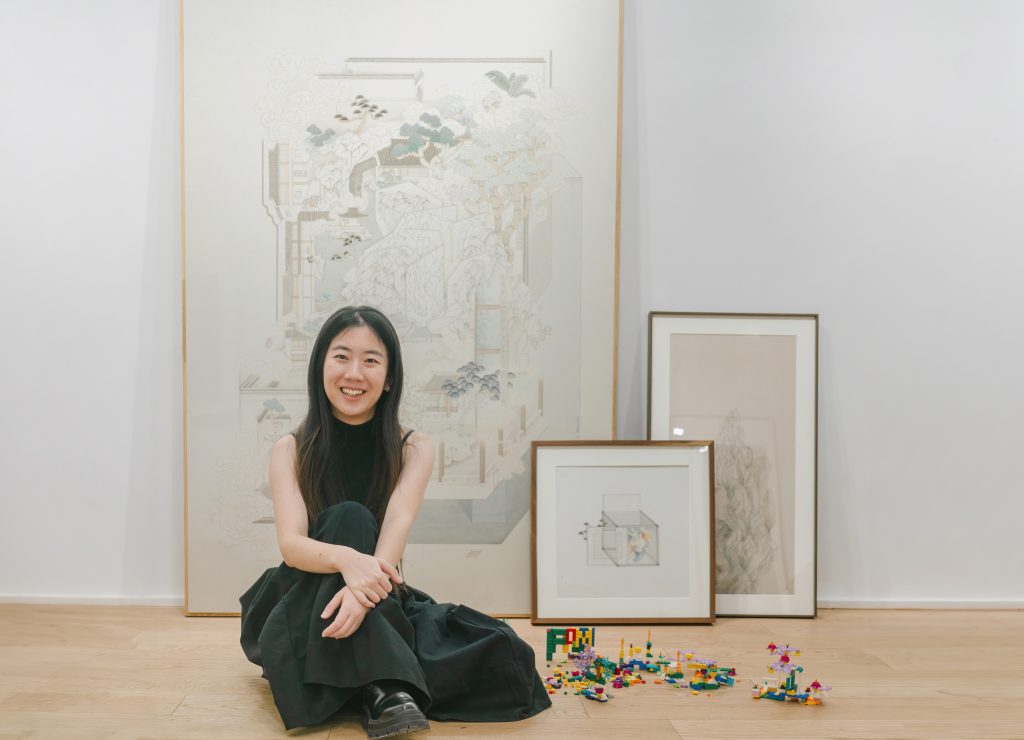
The artist's solo show is currently on view at New York gallery Fu Qiumeng Fine Art.

Cathy Fan

What happens when you combine traditional Chinese ink landscape painting with the playful creativity of Lego toys? That very fusion forms the basis of artist Zhang Xiaoli’s spiritual and artistic experiment. “Just as landscape painting embodies the artist’s innermost spiritual pursuit, I aim to capture the spiritual landscape of post-modern individuals,” says the artist.
Zhang’s journey in art diverges from the typical Western focus on sketching, instead taking root in the traditional Chinese practice of replicating classic works. Her initiation began with the “Mustard Seed Garden Drawings”, a renowned set of paintings from the Qing Dynasty‘s Kangxi period, known for their significant influence on Japanese nanga. These paintings break down landscapes into fundamental elements—stones, tree trunks, leaves—and pairs them with specific painting techniques and compositional principles. This approach reminded Zhang of her childhood experiences with Lego, where she found joy in assembling modules to create “new landscapes”. This inspired her unique method of “imitating” landscape paintings using Lego bricks.
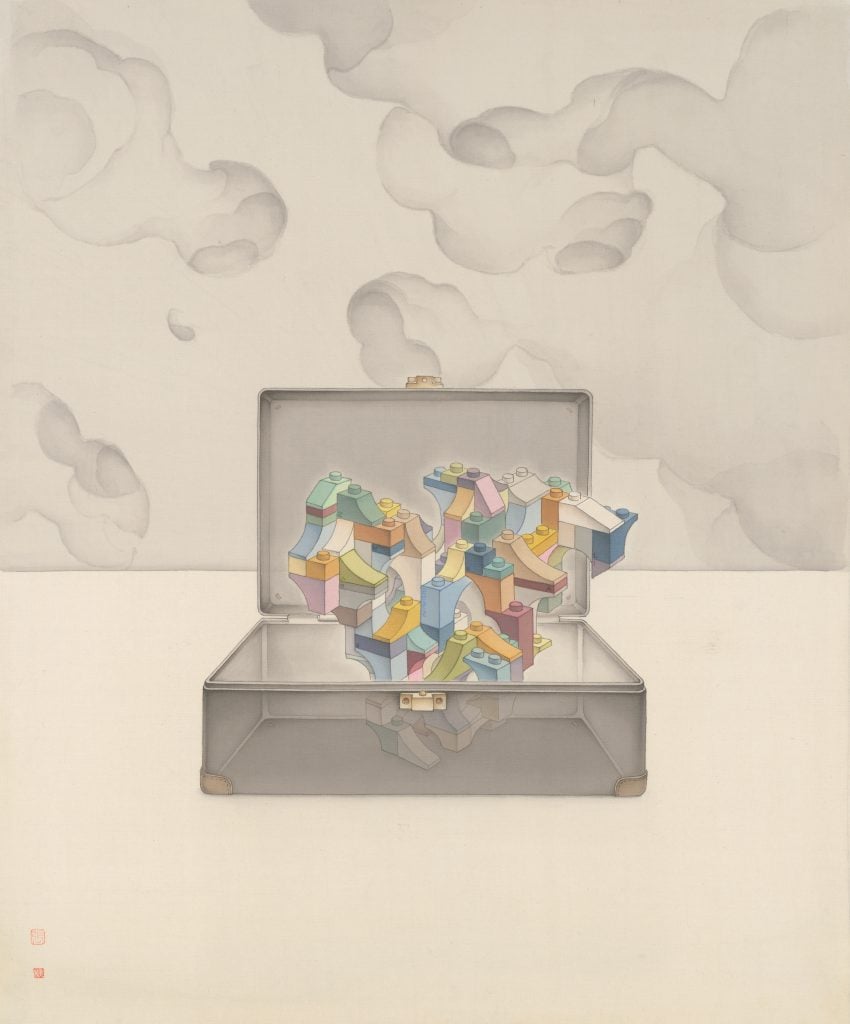
Zhang Xiaoli, The New Stone, 57.5x47cm Ink and colour on Silk, 2022
Zhang likens painting landscapes with Lego to “tickling classical landscapes”, combining the traditional solemnity with a playful injection of modernity.
Before becoming a professional artist, Zhang Xiaoli was engaged in scientific research at the Chinese University of Hong Kong, experimenting with plant genetics to enhance growth and vitality. Her artistic calling led her to Beijing, where she pursued her graduate degree at the Central Academy of Fine Arts School of Chinese Painting, graduating in 2021. Zhang moved to Canada in 2023, taking up residence in a series of six different studios, and now divides her time between Beijing and Toronto.
Her latest solo exhibition, “Whimsical Maze”, is currently on view at Fu Qiumeng Fine Art, an Upper East Side gallery that focuses on classical and contemporary Asian art. We recently caught up with Zhang in New York to discuss her unconventional background in science, the inspirations drawn from her various living spaces, and the “mini zoo” that resides in her studio.
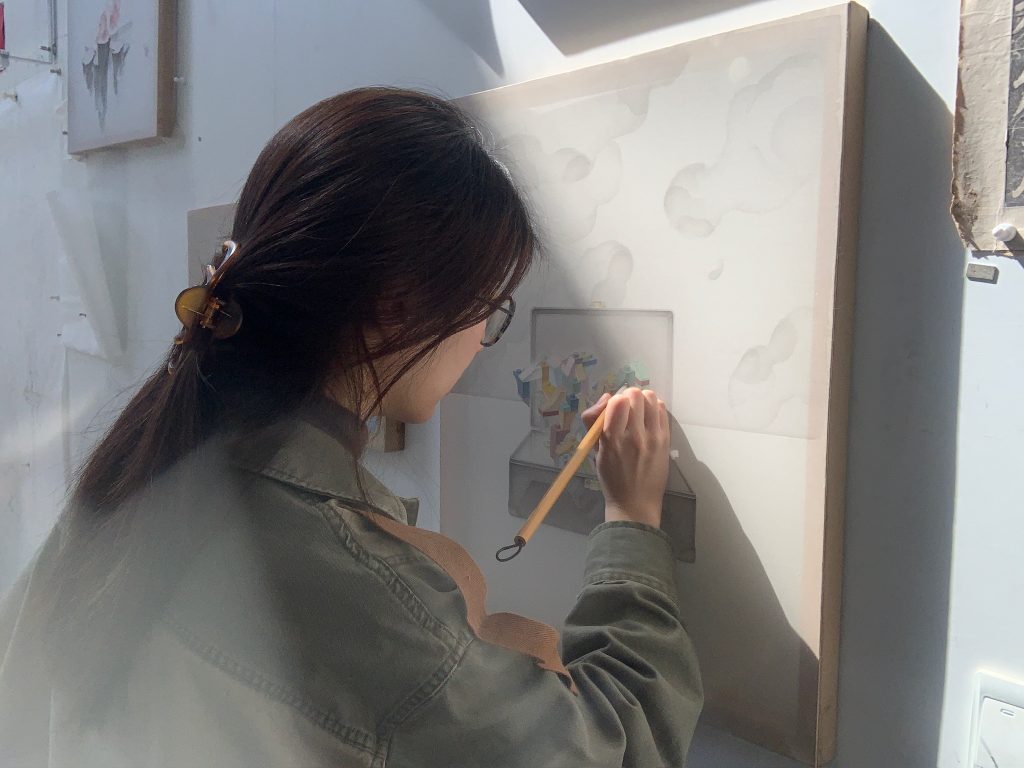
Zhang Xiaoli is working on New Stone from “Boxed Landscape”
Boxes and trays are miniature architectural models. What draws you to them?
The inspiration for the boxed landscape came from my experience of living in confined spaces and moving to Hong Kong. After graduating from the Chinese University in 2014, I moved through several rented apartments and studios. The smallest one was only five square meters. Like an annual herbaceous plant, I took root, sprouted, blossomed, and then was uprooted, moving to another space where I would restart the cycle. Each brief sojourn carries a particular segment of experiences; the box becomes a narrative space, collecting rich memories, and creating a vast landscape within the small world.
Moreover, packaging fragments of landscapes in portable and purchasable containers like trays and boxes are a physical way of cutting weighty traditions into portable pieces. This also reflects the impact of contemporary consumerism, short videos, and fast-food culture on classical art.
What informs your interest in space, portable or fixed?
My interest in space is influenced by various factors. In daily life, I enjoy exploring different possibilities within space. Often, in the studio, I rearrange elements, attempting different layouts to enjoy the various spatial experiences it yields. Sometimes, I feel like the studio is akin to a large-scale Klotski board, just like my work series Klotski.
While doing work, I construct different spatial compartments to define relationships between objects and concepts. Also, dissatisfaction with confining art to two-dimensional planes or creating three-dimensional illusions within these planes drives me to explore constructing impossible spaces on canvas.
From 2019, I started integrating my understanding and imagination of space in the “Boxed” landscape series, blending elements of science with Eastern and Western mysticism to create more intricate spatial compositions, which developed into the mystical landscape series.
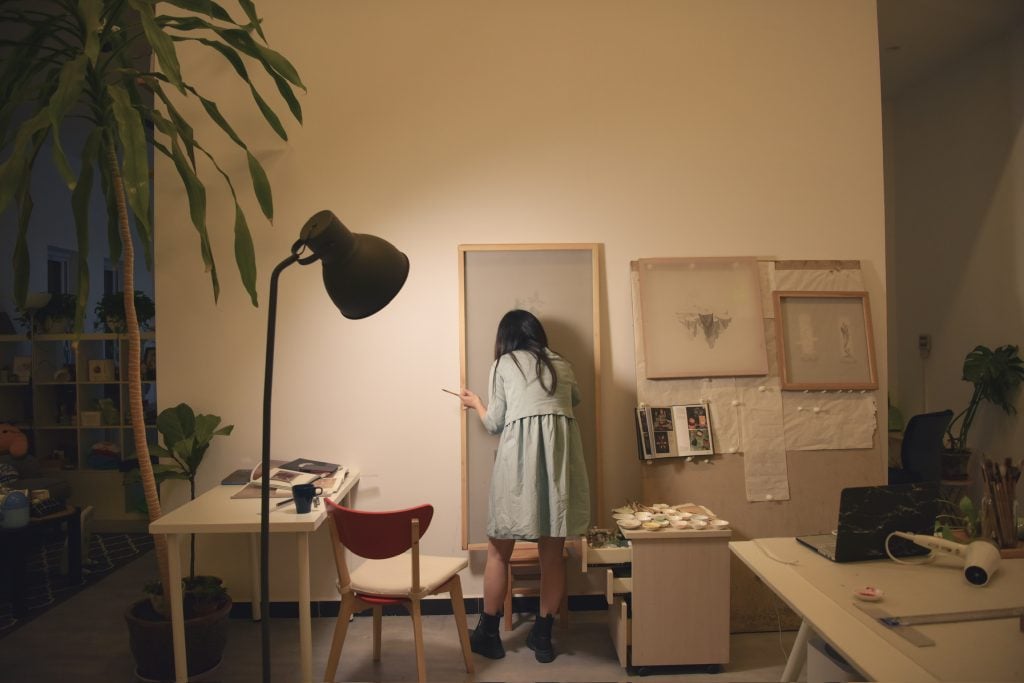
Zhang Xiaoli working in her Beijing home studio
Tell us about your studio. Where is it, how did you find it, what kind of space is it, etc.?
I have lived and worked in six different studios since 2014, spanning from Hong Kong and Beijing to Toronto. Among them, my favorite studio is the one I had in Shunyi, Beijing. It was a two-story building renovated from a natural village homestead. One half of it had a ceiling height of 6 meters, with a loft and a bedroom in the other half. There was a small garden in front of the house where I planted bamboo, Japanese maples, hydrangeas, and roses. Apart from the garden, I particularly loved the skylight on the roof. Beautiful sunset would penetrate through at dusk; and moonlight gently illuminated the studio during late nights. Puddles after the rain cast ripples onto my painting wall. During festivals, fireworks blossomed through the skylight too.
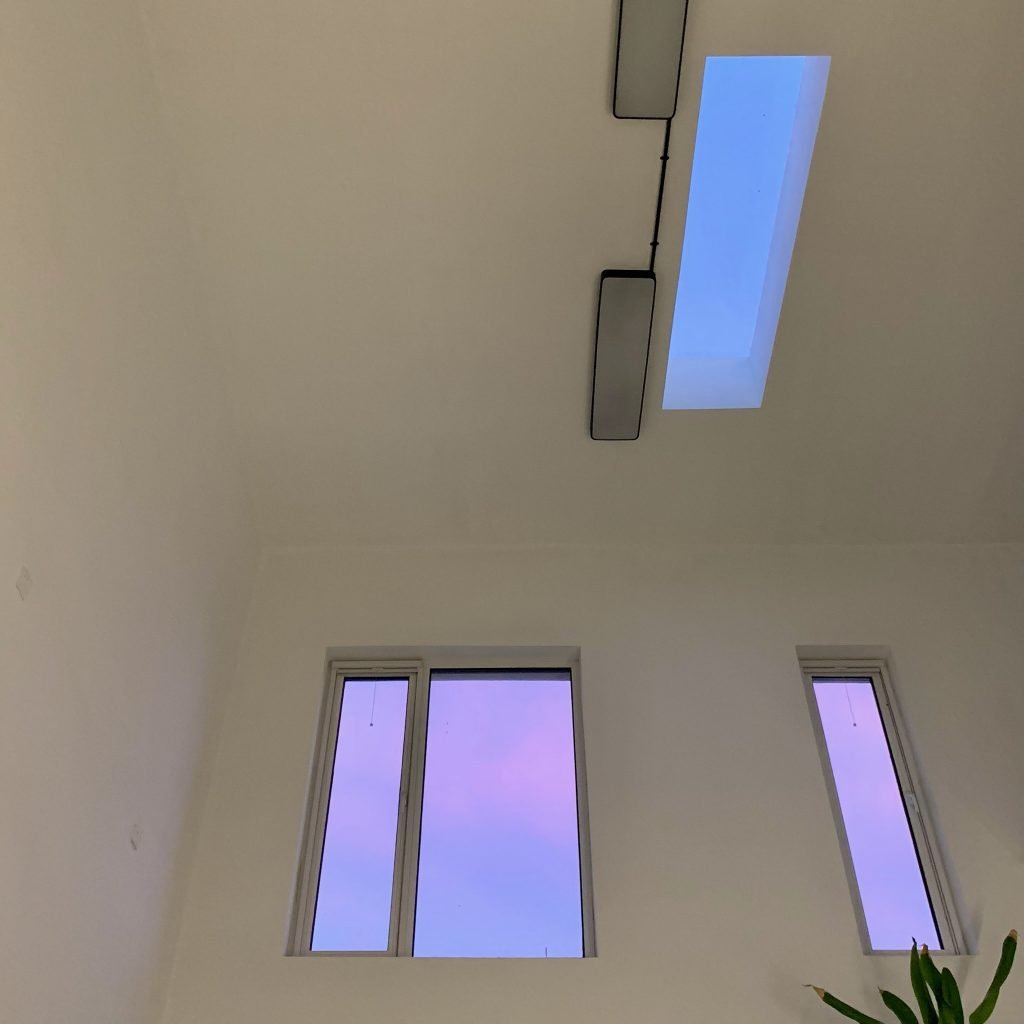
The skylight through the window of Zhang Xiaoli’s studio
What made you choose this particular studio over others?
The first time I visited this studio, it was still a construction site, with just the exterior walls built and no roof. I had a feeling that it was the right place for me, even though it was under construction. I’ve been living and working here for five years, creating many pieces I love, such as Pagoda, Klotski, A Page, etc. Three cats, a snapping turtle, and a one-eyed toad are lively inhabitants of the studio as well.
How many hours do you typically spend in the studio, what time of day do you feel most productive, and what activities fill the majority of that time?
I live in the studio and so spend 24/7 there. During the day, I take care of plants in the courtyard, tidy up the studio, and attend to the animals. I usually start working after dark, with my most productive hours being from midnight to 3 a.m.
When you feel stuck while preparing for a show, what do you do to get unstuck?
Writing calligraphy, reading, or traveling. Writing calligraphy helps me peace my mind, immersing myself completely in the interaction of body, brush, and paper, allowing me to listen to my inner voice. Reading and traveling open up new points of curiosity and provide insights that connect the dots between my thoughts and experiences.
What is the first thing you do when you walk into your studio (after turning on the lights)?
Take a look at the ongoing works. Working in the studio for an extended period can lead to visual fatigue, so coming back after being outside allows me to have a fresh perspective viewing the artwork.
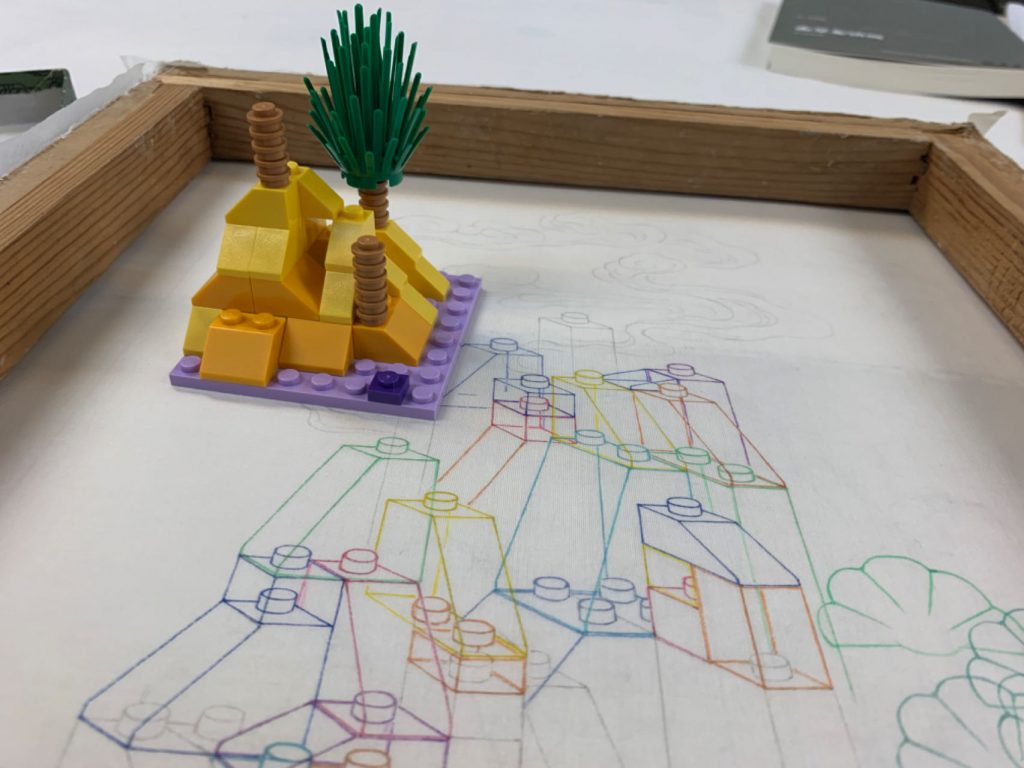
Lego and Zhang Xiaoli’s silk painting
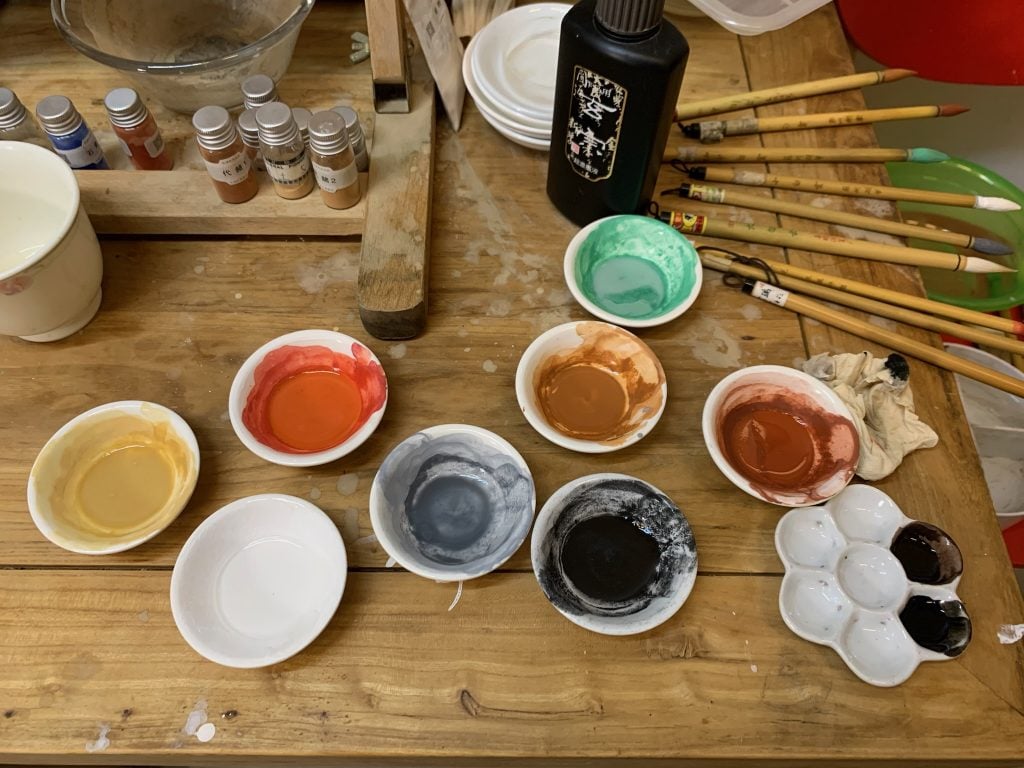
Ink, pigment and brushes that Zhang Xiaoli uses
What tool or art supply do you enjoy working with the most, and why? Please send us a snap of it.
Silk. More than half of my works are on silk. It is a highly unique material closely tied to Chinese history and culture. It is delicate, textured, semi-transparent, and possesses both elasticity and resilience. It can withstand dozens or even hundreds of dyeing and washing cycles without damage, all while sensibly preserving each layer of color with each application. For me, it is a fascinating material that continually draws me in.
Is there anything in your studio that a visitor might find surprising?
Some visitors may feel surprised about the fact that I live and work with naughty cats and avoid their interference when creating meticulous artworks. From my observations, cats are very intelligent and know what things are off-limits. Very, very occasionally, they may cause trouble, like stepping on ink and leaving a trail of paw prints on the painting. Initially, this was a headache for me because fine-line paintings cannot be easily modified; errors are not an option. However, I’ve reevaluated these works as being “enhanced” by the cats; it’s also a challenge posed by my cats: how to embrace chances and accidents in the process of creating (very meticulous) works.
How does your studio environment influence the way you work?
I find this space incredibly relaxing and liberating. Stepping into the studio, I often sense that my spirit diffuses throughout the entire space. Moreover, the tall ceilings and skylights connect with the distant universe, prompting me to contemplate questions related to time and space. This influence is reflected in my artworks.
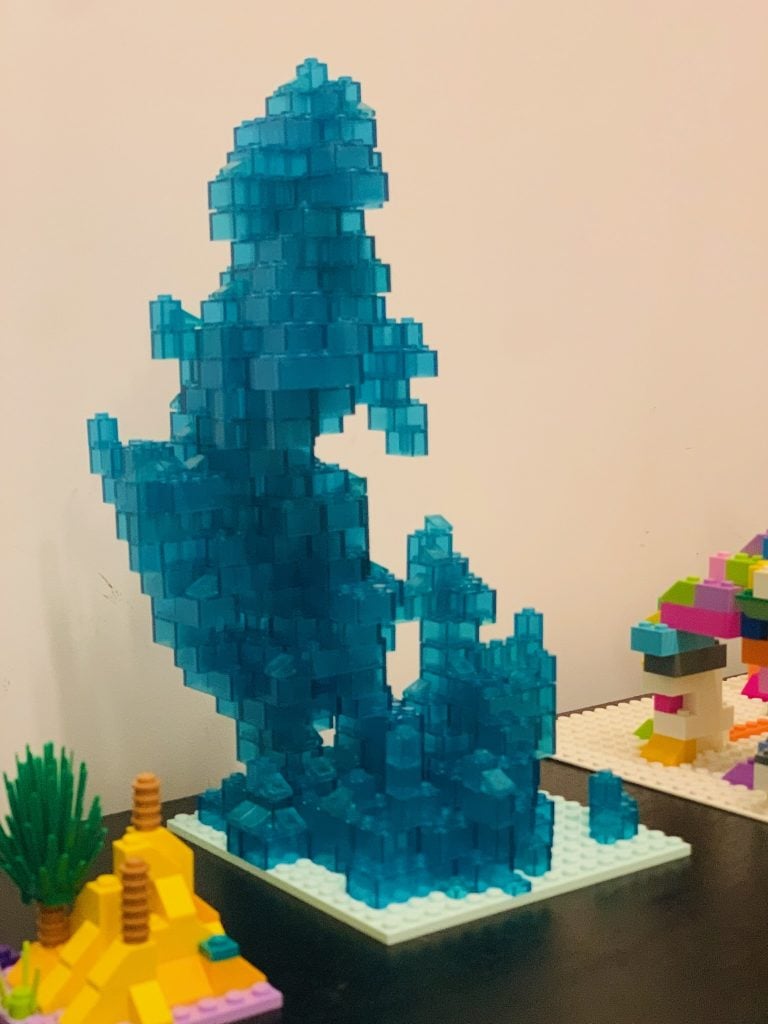
Zhang Xiaoli’s Lego Taihu Stone
What’s the last museum exhibition or gallery show you saw that really affected you and why?
The last museum exhibition that deeply affected me was “Hilma Af Klint & Piet Mondrian: Forms of Life” at Tate Modern. I’ve always admired Hilma Af Klint as an artist. Her early works focused on landscapes and flowers, later transitioning to abstract symbols and scientific imagery. She founded the spiritualist group “The Five,” drawing inspiration and guidance from her mystical experiences. Regarded as one of Europe’s earliest abstract painters, her artworks go beyond the visual, conveying energies beyond sight. The transcendence in her pieces fascinated me. Seeing her large-scale original series “Painting of Temples” in this exhibition was a profound experience. Imagining her creation process, feeling the bodily movements behind the concise and full images, and the harmonious play of light all significantly impacted me. It inspired me to reflect on the opportunities and limitations of fine-line painting techniques, exploring how to subtract and release energy within the frame, and incorporating bodily movement and flow. Inspired by these reflections, I’ve been motivated to experiment with larger-scale creations.
Describe the space in three adjectives.
Bright, Open, Biodiversive.
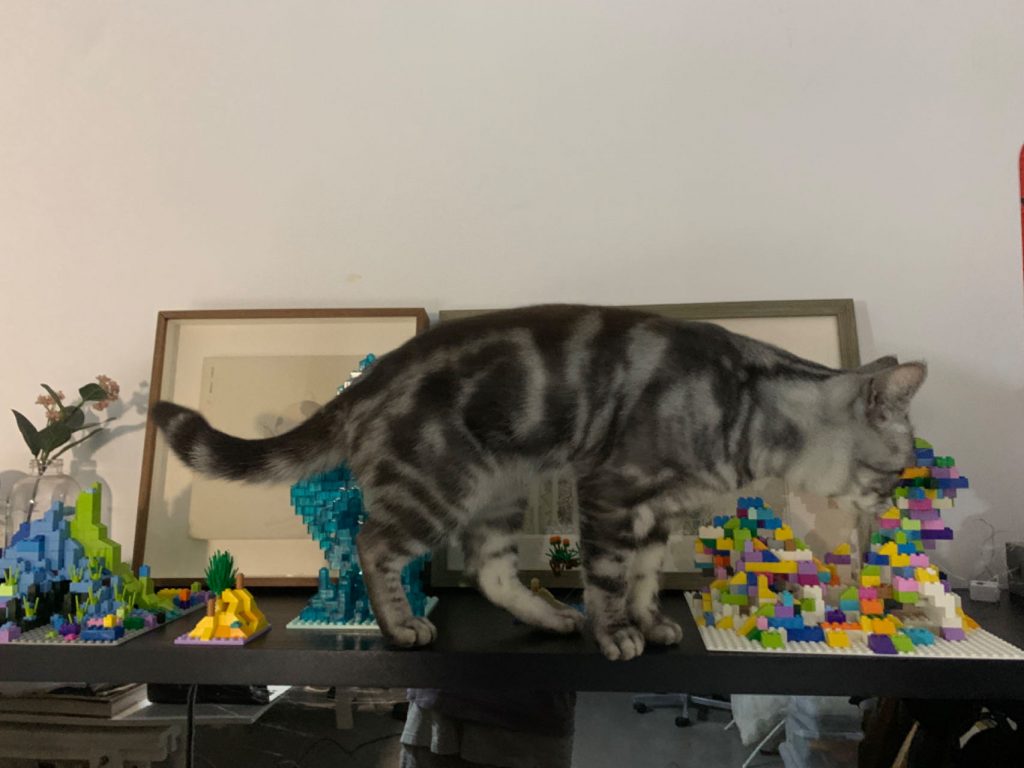
Son of Xiaoli’s cat Pom-Pom playing with LEGO Landscape

Luna chilling on the desk with books and frames
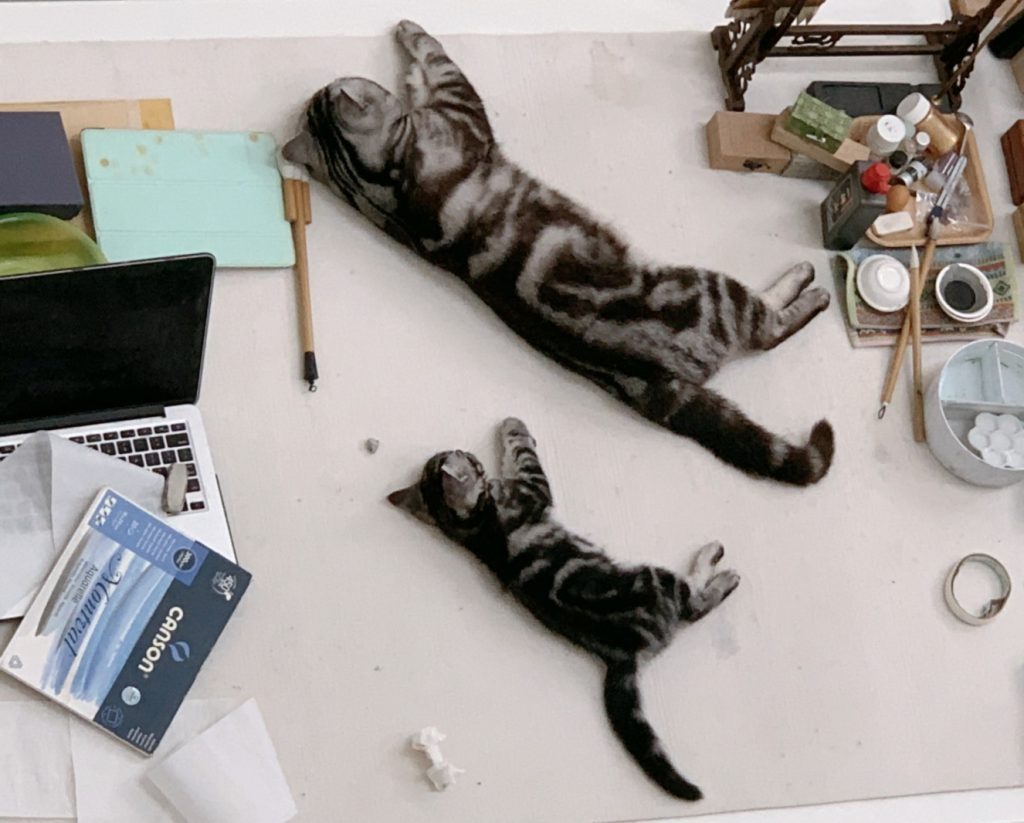
Pom-Pom with his son
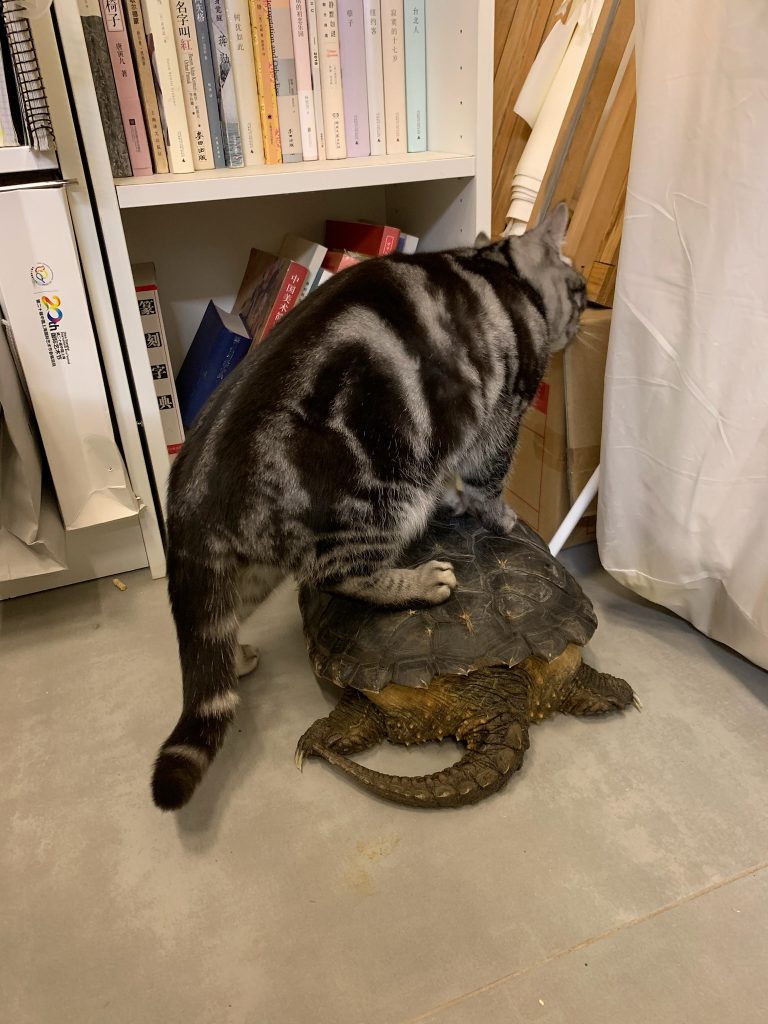
Pom-Pom playing with the turtle
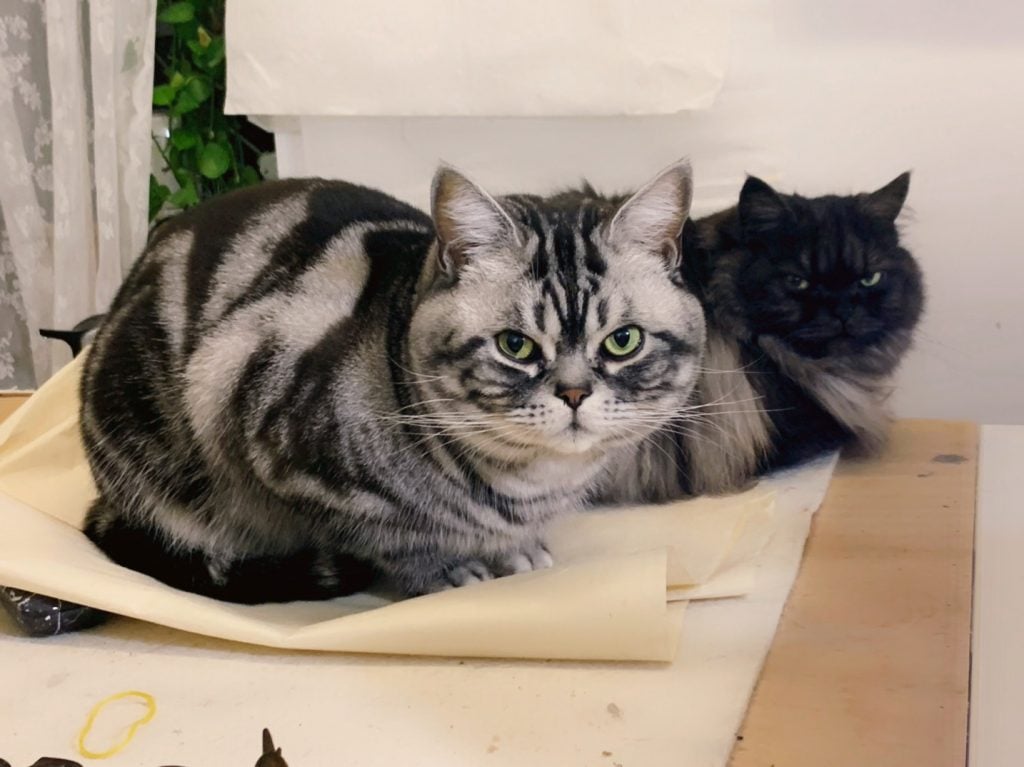
Pom Pom and Zhang Fei sitting on the rice paper
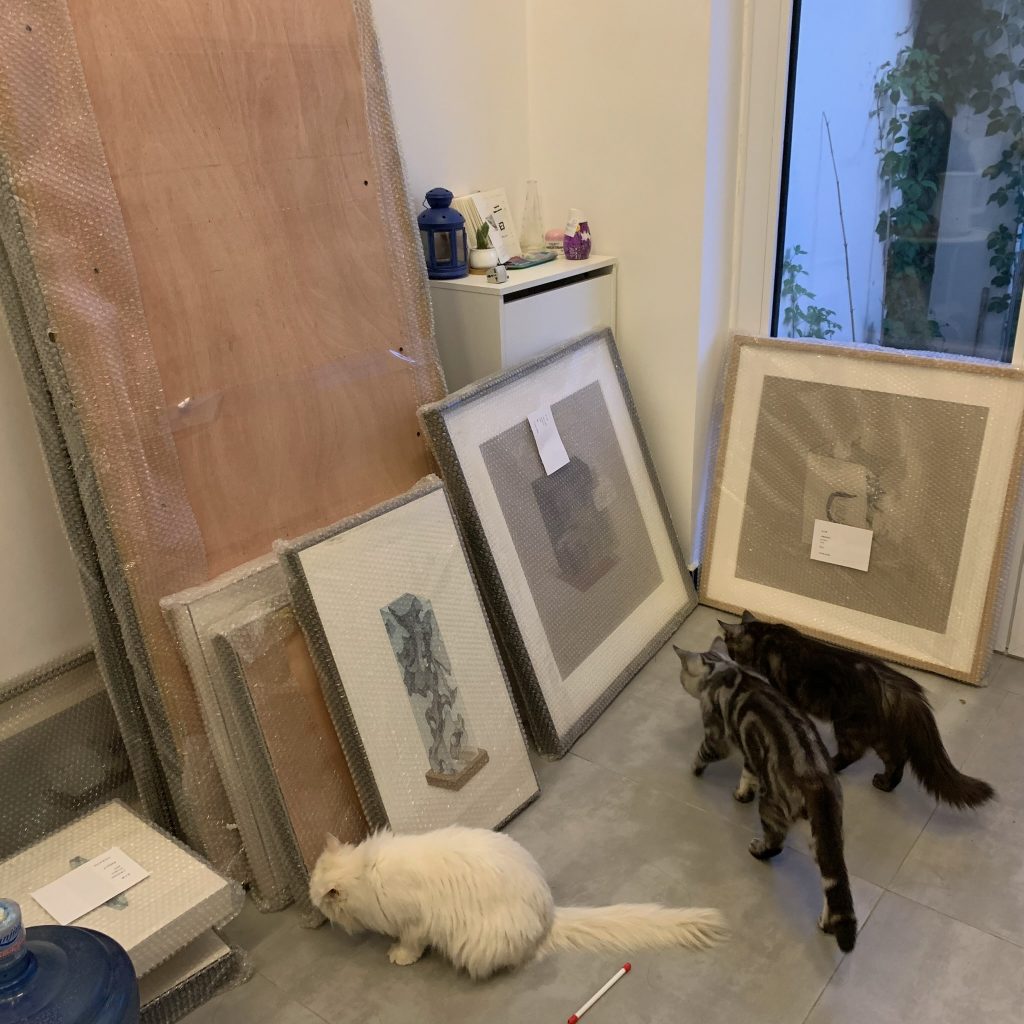
Cats checking the paintings